I recently fell for analog cameras, especially vintage ones. It feels like a rabbit hole much of the time, chasing that elusive, cosmetically beautiful, functionally accurate, 60+ year-old technology (and expecting magic when I find it).
Although I learned photography in journalism school around 1990 and shot for the local paper, I largely stayed within my comfort zone with my trusty Nikon FM2 and a few cheap lenses. I first adopted digital in 1999, and was fully digital by 2002 as a corporate art director and photographer, with professional state-of-the-art digital Nikons (think DCS 760, D1-X). So, knowing next to nothing about this quirky world of aging treasures, I embarked on a buying binge.
And now I own a lot of old broken cameras. But like any treasure hunt, sometimes you find gold or a diamond in the rough. Such was the case with this Kodak Retina IIIC (Big C) I spotted in a lot at a charity auction Website, with its gorgeous leather case and Rodenstock 50mm f/2.0 lens. Introduced in 1957, this was Kodak’s last and best in a long line of folding Retina rangefinder cameras, designed in Kodak’s Nagel factory in Stuttgart, Germany, to compete with Leica, Contax and other German cameras.The Retina is a beautiful design, but shares more of its aesthetics with the past Art Deco era than emerging Mid-Century Modern trends at the time. And thanks to the Nagel factory Kodak bought, it’s also a testament to precision engineering and optics that have stood the test of time.
When I received the camera, inspected it, tested it without film—and briefly researched its potential value—I felt it was good enough to send off for a complete CLA. I sent it to Zacks Camera Repair in Rhode Island. Weeks later it returned, in perfect working order, hopefully for another generation to enjoy.
Using the Kodak Retina IIIC
And then the magic happened. I found the original manual online (at Michael Butkus’ excellent website), and learned the basics of how it was supposed to work. Camera makers were adding selenium light meters to their cameras at the time; many were inaccurate, and most have died from prolonged light exposure over the decades (The Retina IIC is identical but lacks the meter, and is gaining value among collectors because of that). I kind of like the honeycomb look and history of these, though, and as long as they aren’t required for the camera to function, no problem. Because this Kodak Retina IIIC was likely enclosed in its leather case for the last half century, the meter still works. But that doesn’t mean it’s user friendly.
This on-camera metering system does not work like modern ones. Back then, photographers were measuring light with Exposure Values, which you would read off of the meter, and then dial into a complicated, mechanically coupled f-stop and shutter speed assembly on the lens barrel. This is all slow work, especially considering I wear reading glasses—so to do all this I had to keep putting my glasses on, then taking them off again to focus the rangefinder. (I’m convinced human eyesight has greatly deteriorated in the last century, as the older the camera is, the smaller the inscriptions are.) I tried this EV method and quickly gave up. Fortunately, the dials can also be set independently, so I did that and metered with a handheld iPhone app, or just guessed using the “Sunny 16” rule. My Kodak Retina IIIC also came with its original incident light diffuser tucked into the top of the case—which I will never use.
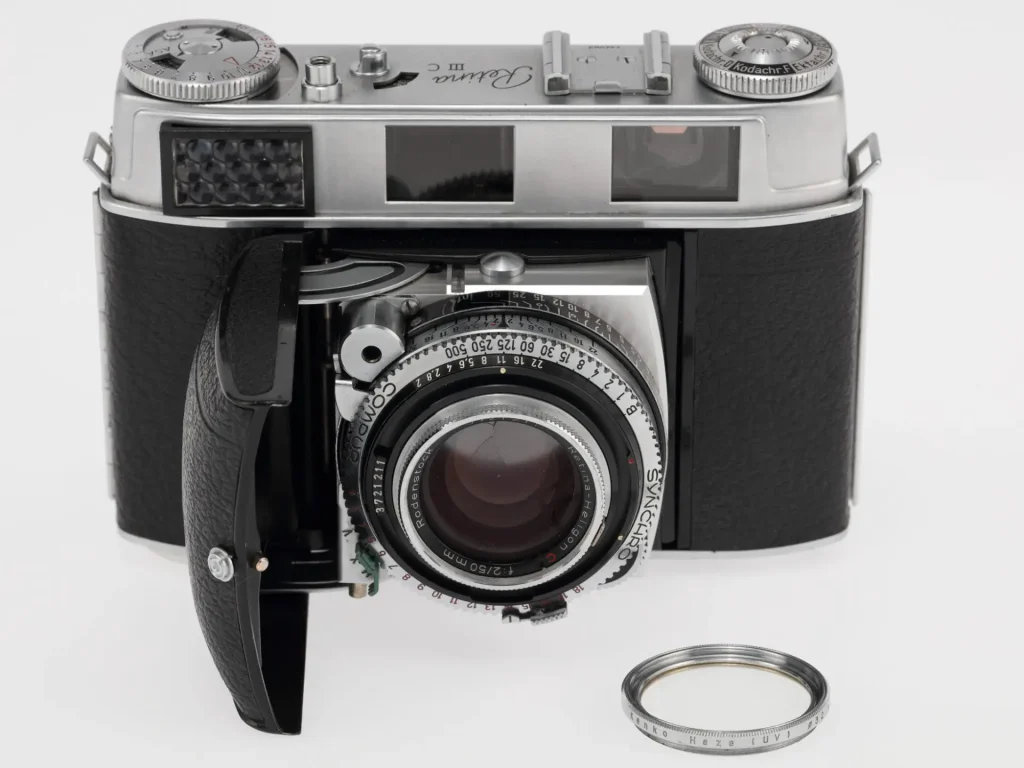
I loaded Kodak Portra 400, and I’m glad I did because it let the excellent Rodenstock Heligon lens shine. Retinas came with Rodenstcok or Schneider-Kreuznach lenses, and the bayonet mounts are different. The Rodestocks were supplied less to begin with, and were mostly distributed in Europe, so they are very rare here in the US. Loading the camera was straightforward, except for setting the film counter manually. The film advance lever is on the bottom right of the camera, which I found easy to get used to. But the ergonomics in general aren’t great, mainly due to the folding door opening out so far to the right that my normal camera grip wouldn’t work. But I got used to holding and focusing with mostly fingers and thumbs, and the leather ever ready case also adds more to hold onto.
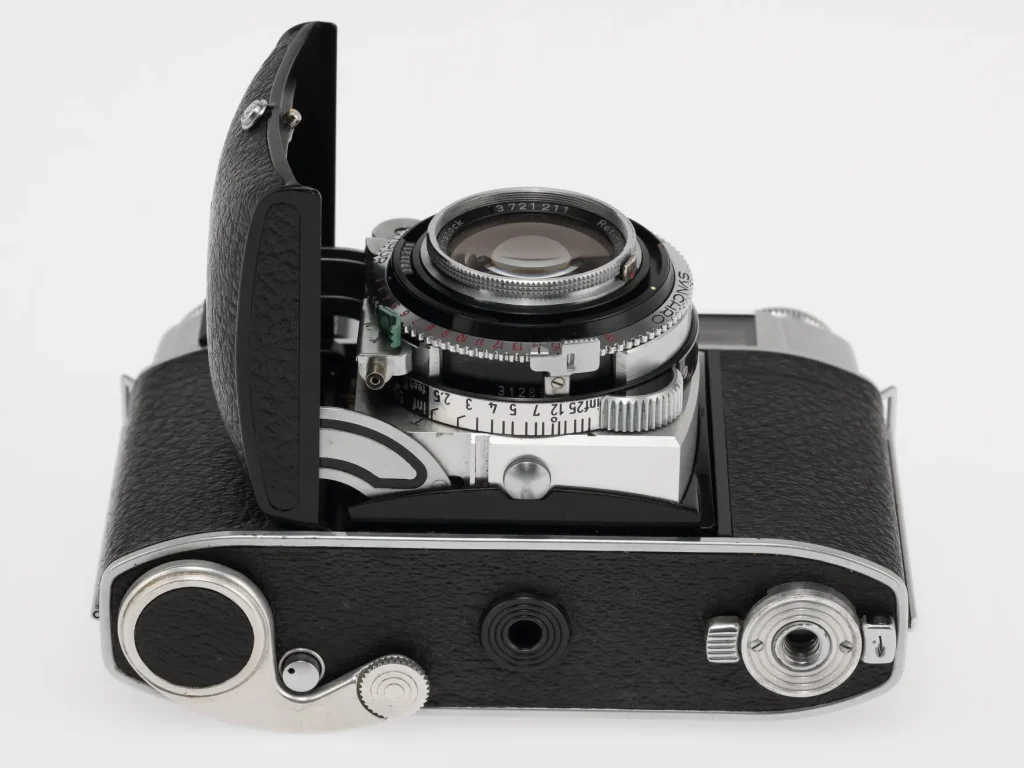
The Kodak Retina IIIC viewfinder is big and bright, with helpful lines showing the field of view for the 35mm, 50mm and 80mm interchangeable lenses (I have only used the standard 50mm so far). I have read some people don’t like the visual clutter of the viewfinder lines, but I always shoot with a grid in modern cameras anyway to help me compose and keep horizons level. Of the older rangefinder viewfinders I’ve used recently, this one is my favorite. The shutter release button is top right, where you would expect, and the focusing ring has a convenient knob on the left for focusing with just a finger. The focus action is smooth but a bit stiff for easy one-finger use. The five blade leaf shutter is very quiet.
In the End
Because I still work full time in a corporate studio, I took the Retina IIIC out on afternoon lunch breaks mostly in Raleigh, NC, so the contrasty light was never optimal. Still, the lens handled almost all situations well—from the nearby nature preserve with dazzling fall foliage, to the oft deserted indoor mall with plenty of natural light, to the Toyota showroom where I was getting an oil change. My final shot was on a tripod at a favorite spot along the Eno River in Durham, NC, which I shot alongside a Kodak Medalist 1 and a Voigtländer Vitessa L. I’ll have something to say about those when that film comes back. Overall, I really enjoyed using the Kodak Retina IIIC—and the images exceeded my expectations—so I will certainly use it again with different films in a more serious way.
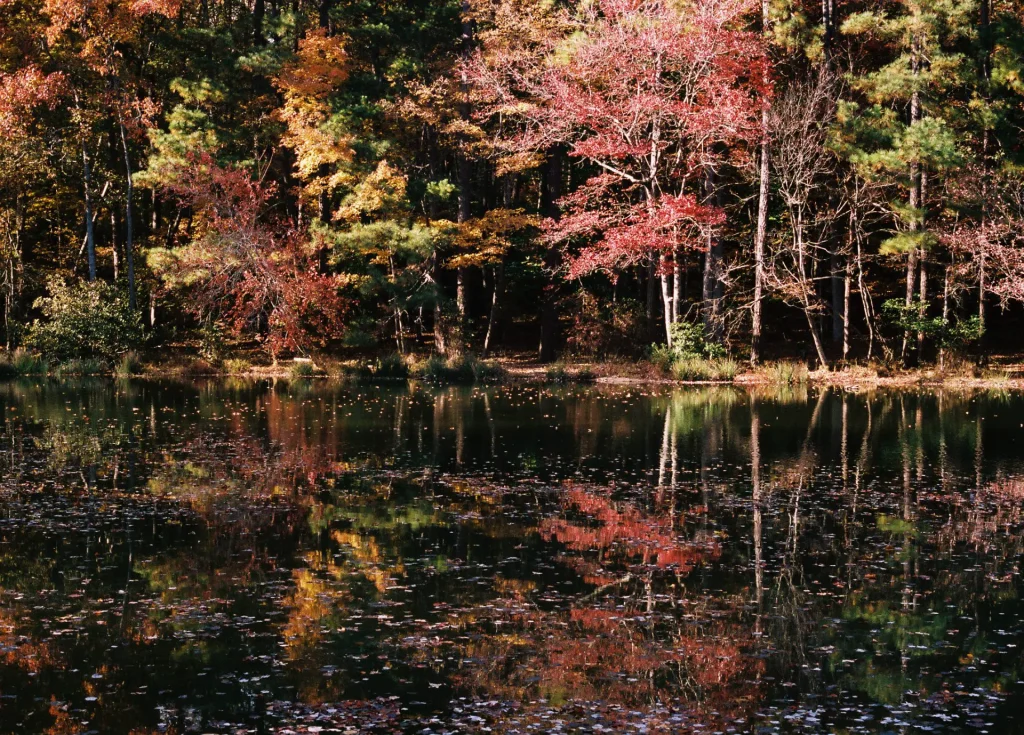
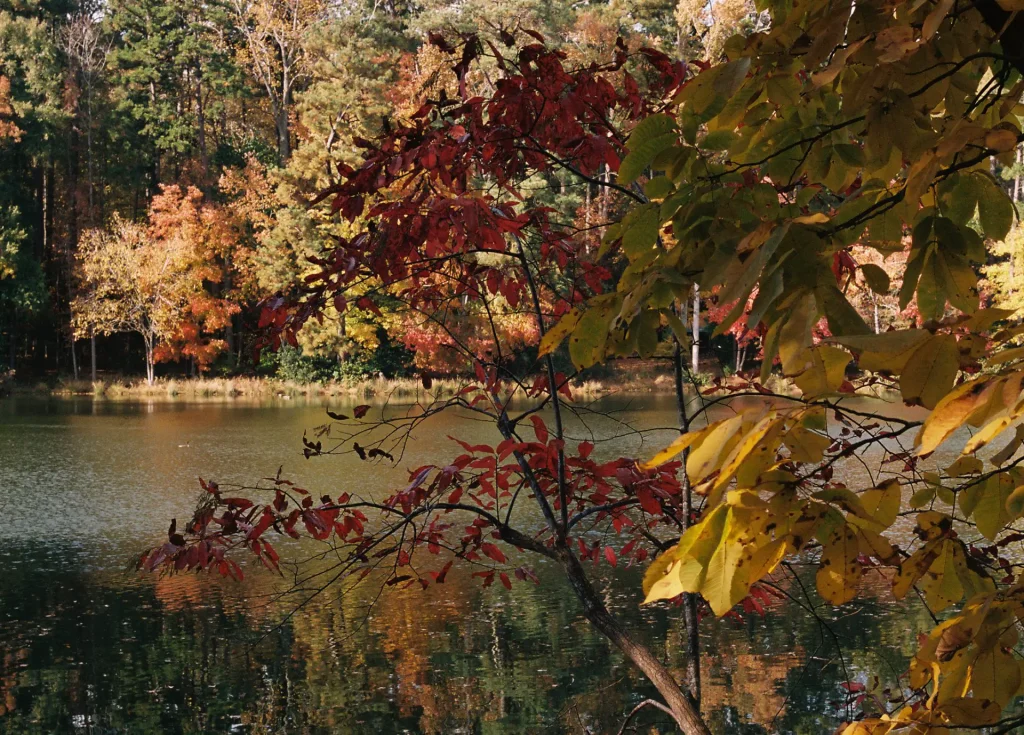


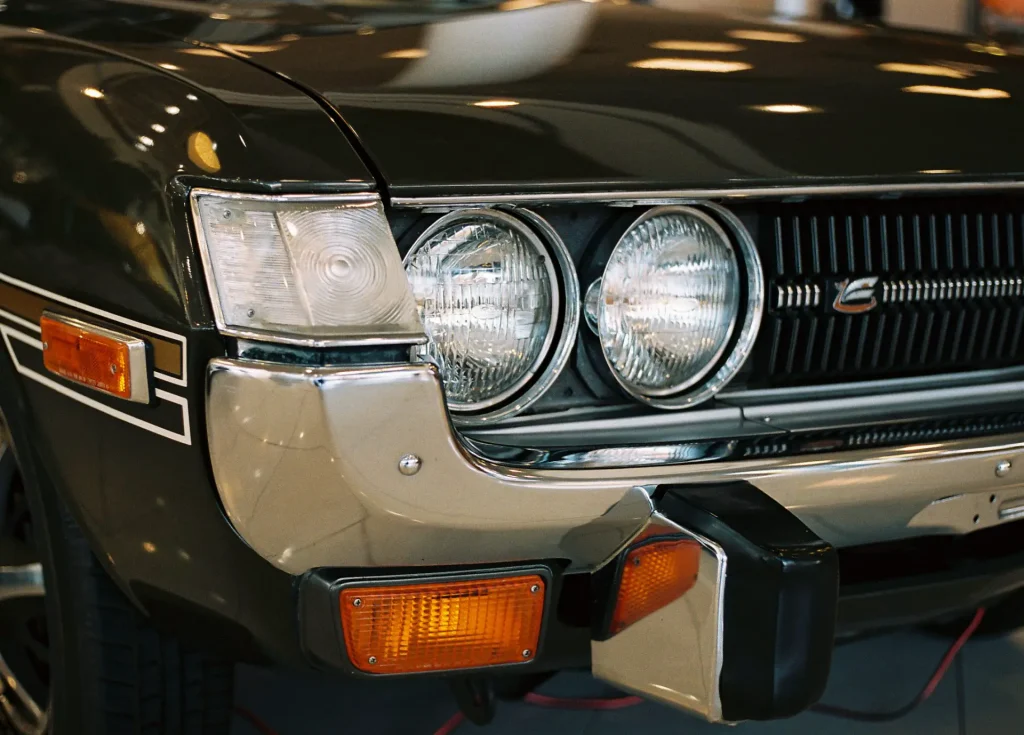
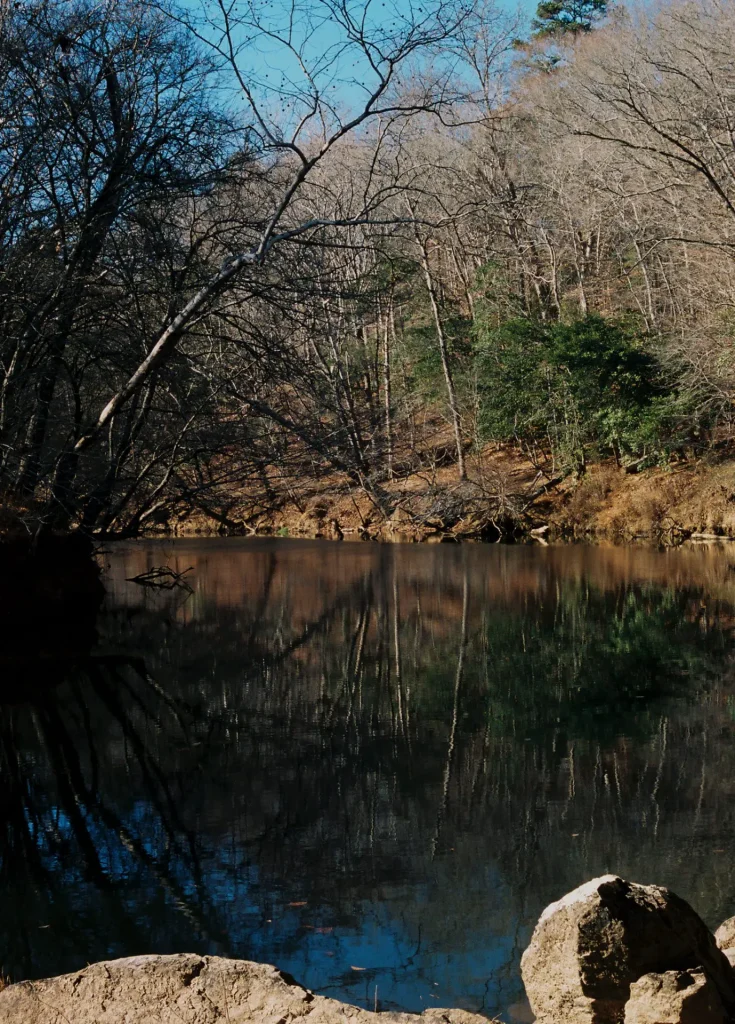
Thank you for reading my first vintage camera review! You can find my photography online at Facebook, Instagram and stewartwallerphotography.com.
Share this post:
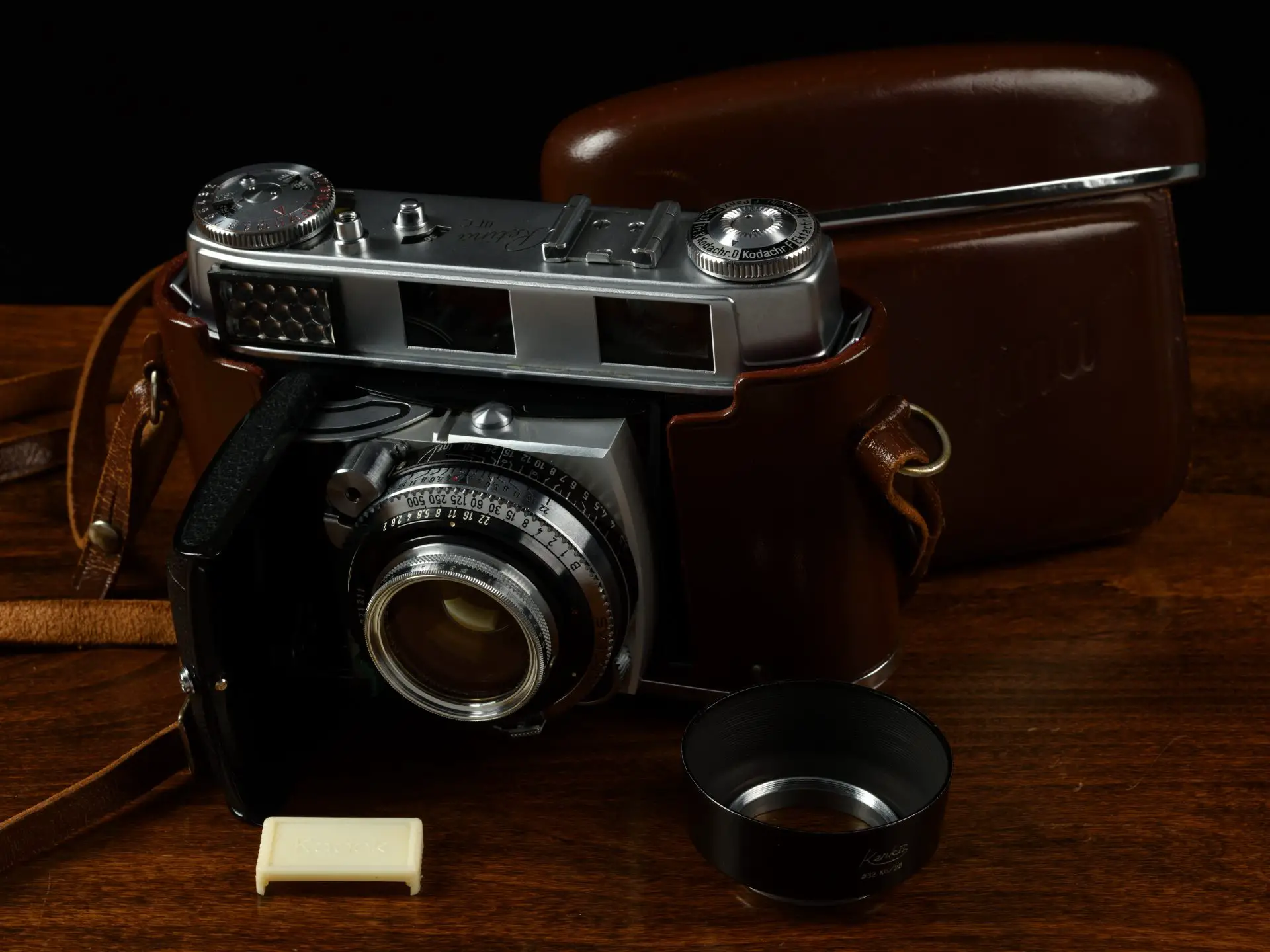








Comments
Martin Siegel on Kodak Retina IIIC – Back into Film with a Charity Auction Find – By Stewart Waller
Comment posted: 31/01/2022
Every one reading this and downloading a manual from Mike Butkus - please don't forget to donate the 3 Dollars, it's not much but helps a lot in keeping the site going.
Comment posted: 31/01/2022
John Tarrant on Kodak Retina IIIC – Back into Film with a Charity Auction Find – By Stewart Waller
Comment posted: 31/01/2022
Dave Roberts on Kodak Retina IIIC – Back into Film with a Charity Auction Find – By Stewart Waller
Comment posted: 31/01/2022
Neal A Wellons on Kodak Retina IIIC – Back into Film with a Charity Auction Find – By Stewart Waller
Comment posted: 31/01/2022
I got some great shots with the Retinas and also used them a lot for infrared images. But they just didn't feel right and I didn't like the size,weight and EV linkage of the IIIc. The Ia was better in those areas but had no rangefinder which was OK. Still, I didn't like the feel of it compared to the Barnacks.
Comment posted: 31/01/2022
John Bennett on Kodak Retina IIIC – Back into Film with a Charity Auction Find – By Stewart Waller
Comment posted: 31/01/2022
https://www.facebook.com/groups/KodakRetinaRetinetteLovers
Comment posted: 31/01/2022
Lee on Kodak Retina IIIC – Back into Film with a Charity Auction Find – By Stewart Waller
Comment posted: 31/01/2022
Comment posted: 31/01/2022
Daniel Castelli on Kodak Retina IIIC – Back into Film with a Charity Auction Find – By Stewart Waller
Comment posted: 31/01/2022
A nice article. In this day and age, we forget what a giant Kodak was in the photography business. I taught graphic arts and (litho) printing. The depth of products and support Kodak offered to the printing industry was legendary.
The Retina camera line appealed to the high-end amateur photographer. The concept: a pocketable 'folder' producing first rate photos still has a strong following today.
I followed your link to Zack's Camera repair and have contacted them about a repair. Thanks for mentioning them.
Wishing you a lot of success with the camera.
Comment posted: 31/01/2022
Paul Tranto on Kodak Retina IIIC – Back into Film with a Charity Auction Find – By Stewart Waller
Comment posted: 31/01/2022
Comment posted: 31/01/2022
JAMES LANGMESSER on Kodak Retina IIIC – Back into Film with a Charity Auction Find – By Stewart Waller
Comment posted: 31/01/2022
Comment posted: 31/01/2022
Steve Ember on Kodak Retina IIIC – Back into Film with a Charity Auction Find – By Stewart Waller
Comment posted: 31/01/2022
It was also encouraging that you found a competent repair shop for such equipment in Zack's. And, while I have a fairly sizable collection of film SLR's, your description has moved me several steps closer to pulling the trigger on a Retina III-C to - really - slow down the shooting process, especially after viewing your sample photos - I especially like that first autumn landscape.
Hopefully, I can find one in as lovely condition as yours seems to be. Nicely photographed, by the way!
Comment posted: 31/01/2022
Jim Hanes on Kodak Retina IIIC – Back into Film with a Charity Auction Find – By Stewart Waller
Comment posted: 01/02/2022
Stefan Wilde on Kodak Retina IIIC – Back into Film with a Charity Auction Find – By Stewart Waller
Comment posted: 01/02/2022
great story, great shots! I have shot a vintage TLR mostly now, bug you have inspired me to finally try out that Retina Ia I inherited from my uncle. Just a question: I was told lately that Selenium cells actually do not deteriorate noticeably from exposure to light. They seem to be affected by oxygen and corrode, when the seals on the cell break. Do you happen to know if that is the case?
Comment posted: 01/02/2022
Comment posted: 01/02/2022
Comment posted: 01/02/2022